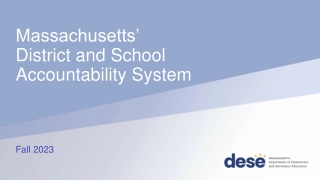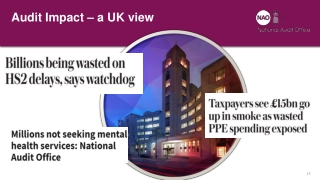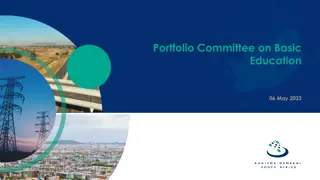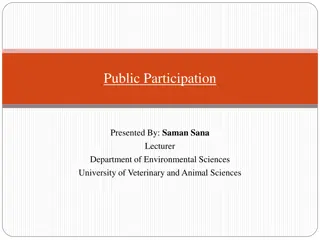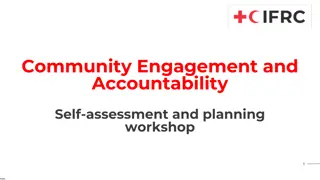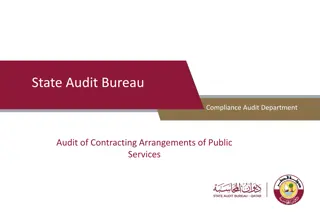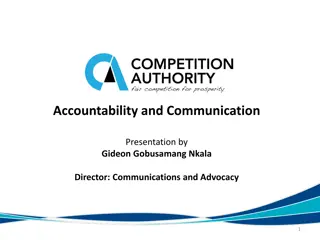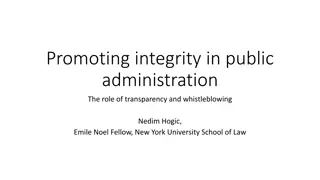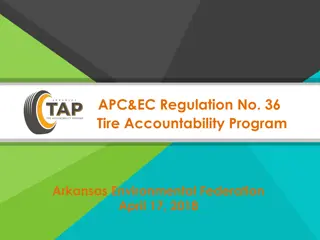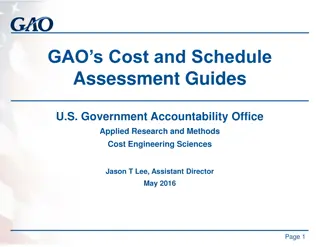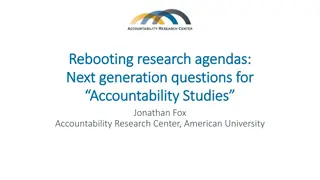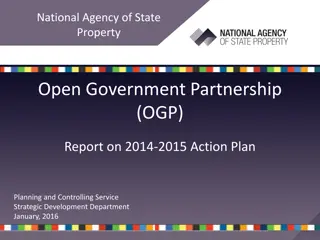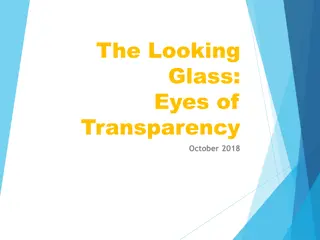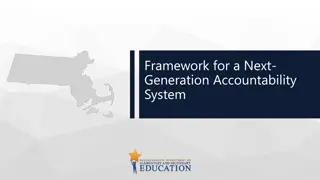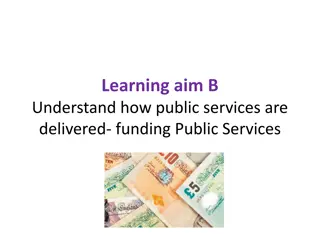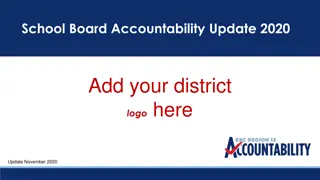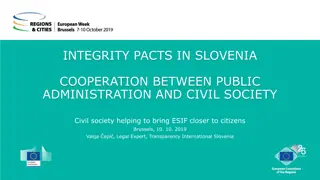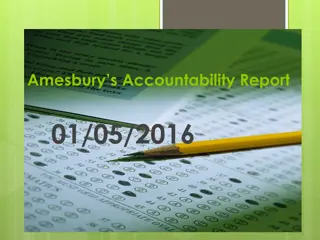Enhancing Accountability in Public Management
Accountability in public management is crucial for maintaining trust with public resources. Holding public managers accountable improves performance, promotes ownership, builds trust, fosters creativity and innovation, and increases commitment to work. Examples of accountability failures include financial losses, abuse of power, and inadequate service delivery, all of which have negative impacts on socio-economic development. Legal and institutional frameworks play an essential role in enforcing accountability and preventing corruption.
Download Presentation

Please find below an Image/Link to download the presentation.
The content on the website is provided AS IS for your information and personal use only. It may not be sold, licensed, or shared on other websites without obtaining consent from the author.If you encounter any issues during the download, it is possible that the publisher has removed the file from their server.
You are allowed to download the files provided on this website for personal or commercial use, subject to the condition that they are used lawfully. All files are the property of their respective owners.
The content on the website is provided AS IS for your information and personal use only. It may not be sold, licensed, or shared on other websites without obtaining consent from the author.
E N D
Presentation Transcript
BUSINGYE Johnston Minister of Justice / Attorney General BUSINGYE Johnston Minister of Justice / Attorney General 1
Accountability means: obligation to render account for a responsibility conferred. the liability assumed for the manner in which entrusted responsibility is fulfilled. obligation to demonstrate that work has been conducted as agreed. reporting fairly and accurately on performance results vis- -vis mandated roles and or/plans. 2
The rationale for holding public managers accountable lies in their relationship of trust with public resources. The Public are entitled to know how responsibility with regard to this trust is discharged. Citizens have a right to know the actions taken in their name; Measures should be in place to force corrective action when trustees act in an illegal, negligent, or unjust manner. 3
Improves performance; Promotes ownership; Builds trust; Creativity and innovation; Increased commitment to work; Higher employee morale and satisfaction; More employee participation and involvement, etc.. 4
Examples: Avoidable/preventable financial Loss. Eg: Investing public funds in projects with poor or without prior feasibility studies; Awarding unplanned tenders Abuse of power/office; Procuring unnecessary or sub-standard assets; Lack of leadership action; Open ended corruption and embezzlement 5
Unnecessary law suits against GoR Retardation of Socio-Economic Development Negative effects on GDP, Jobs, Growth, Taxes etc... Failure of effective service delivery; Undermining trust in Government . 6
Legal framework Legal framework Leadership code of conduct; Law on prevention of corruption and related offences; Law relating to access to information Presidential Order determining modalities for a leader to receive or give donations and gifts; Law on State Finance and Property; Law relating to the protection of whistleblowers Ministerial Instructions on holding liable public servants who cause loss to the state Law determining penalties and offences (Penal Code), etc. Institutional framework Parliament Auditor General s Office Ombudsman RGB; Judiciary; NPPA RIB, etc. Institutional framework 7
Delays valued at Frw either delayed or abandoned. Delayed agreed contracts. Poor project feasibility studies which lead to delay and abandonment of projects. The above cases have resulted in: increased cost of Government projects, significant delays in completion; and lack of value for money for many government projects. This adversely affects service delivery to citizens. This retards socio-economic transformation [NST] Delays & & Abandonment Frw 143 Abandonment : : A total of 86 143, ,255 86 contracts 255, ,975 975, ,651 651 are reported as Delayed payment payment: : Contractors not paid on time as resulting in delayed and abandoned 8
Cases 21 35 inadequate contract management. Planned objectives were not fully realised, and government is not realizing value for money uncompleted works; Inadequate due diligence. Cases of 21 cases of stalled projects worth Frw 35, ,766 of stalled stalled projects projects Frw from 766, ,513 513, ,559 559 that resulted from expenditure incurred on 9
Failure performance ( (15 performance securities worth Frw failure of contractors to execute contracted works. Public entities are not doing adequate follow up to ensure that funds are recovered within reasonable time. This denies these public entities funds that would have been utilized to complete the planned activities. This [NST] Failure performance securities 15) ) entities did not recover advance payment and to to recover securities recover advance advance payment payment and and Frw 2 2, ,297 297, ,606 606, ,521 521 from retards socio-economic transformation 10
Leaders, have a responsibility to ensure that litigation avoidance and litigation management policies and procedures are in place. Disputes come from decisions/ actions we make or don t make/take. Simple ! The best way to manage litigation is not to get into it in the first place by avoiding habits, toxic cultures and other situations that breed lawsuits. It is increasingly evident that GoR agencies that do the right thing have fewer lawsuits and, accordingly, lower litigation footprint, costs and damage awards. Litigation management has three poles: - Litigation prevention - Cost-effective resolution of disputes - winning un avoidable court litigation 12
The job of avoiding litigation is challenging and involving-but worth every effort. It boils down to one rule: Make sure the institution and its employees do the right thing. Good corporate governance is a primary means of ensuring that the institution does the right thing. It fosters a culture of accountability in the workplace. A key feature of lawsuit avoidance, is a culture of respect and integrity, a code of conduct that is a basis for training, monitoring, and enforcement of proper employee behaviour, including decisions made on behalf of the GoR agency itself. 13
Good corporate governance helps prevent a significant amount of risky actions/omissions, and other misconduct. It also helps build ethical competence and the ability to make the right decisions. This is likely to reduce the occasion for litigation, but there is need to evaluate strategies so we know which have little or no effect. Its advisable as a leader to consider the following parameters: 1. Determine the frequency with which lawsuits (commercial, administrative etc) are brought against the Institution/GoR agency. 2. For each type of law suit, work with the in-house legal advisors to understand and learn what kinds of conduct leads to litigation and what evidence typically leads to significant damage awards, and work together to establish preventive practices. 3. Establish a database of information on a) lawsuits filed against the your Institution (the claims, costs, and outcomes), b) steps taken following lawsuits to prevent their re-occurrence. 4. Involve the whole institution - inform, sound the alarm, call individuals out, etc. 14
Each lawsuit will affect your business. It is critical to understand what litigation might cost, measured in more than money and to consider pathways to amicable resolution, ADRs (mediation or transaction) short of a win in the courtroom, that are helpful to the overall strategy of GoR especially when you have a weak case. Work with your legal advisors upfront on those criteria you need to apply to resolve the dispute as the process unfolds. Alternative dispute resolution (ADR) may be a best option ( amicable resolution, transaction and mediation). Either party can seek to have the dispute resolved outside of the litigation process at any time. Additionally, courts frequently push parties toward these processes. 15
Once a lawsuit is filedwhether your institution is the plaintiff or defendant GoR should win if you have properly managed the process. However, this has been a challenge due to the following: No communication or slow response to letters, e-mails and inquiries sent by MINIJUST (running away/hiding from the case) Failure to submit case evidence and GoR positions on the litigation case in time Failure to transmit litigation information in time to the extent that preliminary procedures are sometimes conducted in default of GoR Failure to transmit summons to MINIJUST to the extent that cases are heard in default of GoR agencies Weak litigation case ownership by CBMs (an inconvenience left for only legal officers). Wrong expertise: complaining for lost litigation 16
As leaders we are hired to ensure accountability and effective delivery. Our leadership role and oversight is precisely for that. Short of it NST is dead! As leaders we must work to ensure successful and effective execution and instill this in our subordinates; Accountability can not co-exist with conflict of interest and complacency. In the face of perceived or real corruption, poor contract management or any other act that may lead to loss, leaders stand up and face the problem without fear and favour; 17
Public funds serve a common interest; they have to be protected against misuse by us all. Poor contract management leads loss of funds, time, image, credibility, multiplier losses, etc... Awareness and effective leadership are a key to best contract management practice It is always important to comply with law to be sure you are managing contract well. Any public servant causing loss to Gvt due to poor contract management or other avoidable commission/omission should account for it. That is where GoR is!! Litigation is preventable, avoidable, resolvable, or winnable provided we do the right things along the process. Always watch out for conflict of interest. 18


